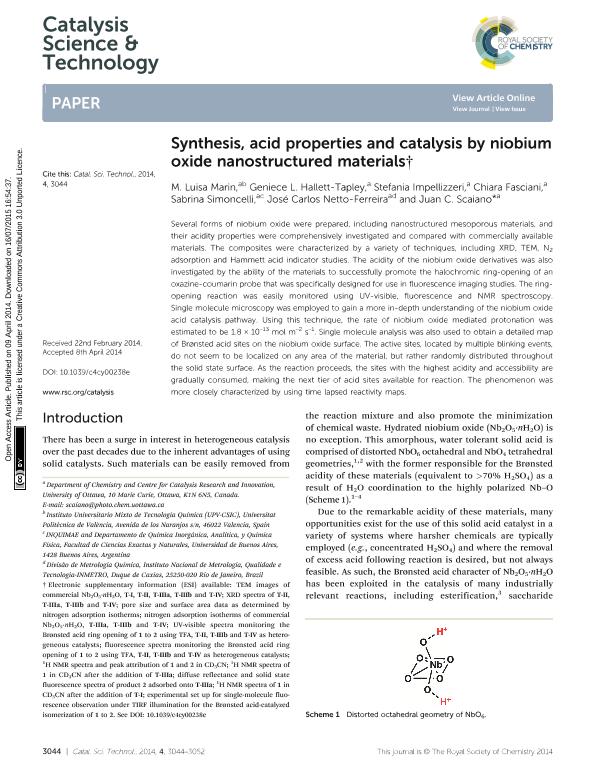Mostrar el registro sencillo del ítem
dc.contributor.author
Marin, M. Luisa
dc.contributor.author
Hallett Tapley, Geniece L.
dc.contributor.author
Impellizzeri, Stefania
dc.contributor.author
Fasciani, Chiara
dc.contributor.author
Simoncelli, Sabrina

dc.contributor.author
Netto Ferreira, José Carlos
dc.contributor.author
Scaiano, Juan C.
dc.date.available
2016-02-10T15:44:33Z
dc.date.issued
2014-04
dc.identifier.citation
Marin, M. Luisa; Hallett Tapley, Geniece L.; Impellizzeri, Stefania; Fasciani, Chiara; Simoncelli, Sabrina; et al.; Synthesis, acid properties and catalysis by niobium oxide nanostructured materials; Royal Society of Chemistry; Catalysis Science & Technology; 4; 9; 4-2014; 3044-3052
dc.identifier.issn
2044-4753
dc.identifier.uri
http://hdl.handle.net/11336/4095
dc.description.abstract
Several forms of niobium oxide were prepared, including nanostructured mesoporous materials, and their acidity properties were comprehensively investigated and compared with commercially available materials. The composites were characterized by a variety of techniques, including XRD, TEM, N2 adsorption and Hammett acid indicator studies. The acidity of the niobium oxide derivatives was also investigated by the ability of the materials to successfully promote the halochromic ring-opening of an oxazine-coumarin probe that was specifically designed for use in fluorescence imaging studies. The ring-opening reaction was easily monitored using UV-visible, fluorescence and NMR spectroscopy. Single molecule microscopy was employed to gain a more in-depth understanding of the niobium oxide acid catalysis pathway. Using this technique, the rate of niobium oxide mediated protonation was estimated to be 1.8 x 10^-13 mol m^-2 s^-2. Single molecule analysis was also used to obtain a detailed map of Brønsted acid sites on the niobium oxide surface. The active sites, located by multiple blinking events, do not seem to be localized on any area of the material, but rather randomly distributed throughout the solid state surface. As the reaction proceeds, the sites with the highest acidity and accessibility are gradually consumed, making the next tier of acid sites available for reaction. The phenomenon was more closely characterized by using time lapsed reactivity maps.
dc.format
application/pdf
dc.language.iso
eng
dc.publisher
Royal Society of Chemistry
dc.rights
info:eu-repo/semantics/openAccess
dc.rights.uri
https://creativecommons.org/licenses/by/2.5/ar/
dc.subject
Niobium Oxide
dc.subject
Acid Properties
dc.subject
Catalysis
dc.subject
Single Molecule
dc.subject.classification
Química Coloidal

dc.subject.classification
Ciencias Químicas

dc.subject.classification
CIENCIAS NATURALES Y EXACTAS

dc.title
Synthesis, acid properties and catalysis by niobium oxide nanostructured materials
dc.type
info:eu-repo/semantics/article
dc.type
info:ar-repo/semantics/artículo
dc.type
info:eu-repo/semantics/publishedVersion
dc.date.updated
2016-03-30 10:35:44.97925-03
dc.journal.volume
4
dc.journal.number
9
dc.journal.pagination
3044-3052
dc.journal.pais
Reino Unido

dc.journal.ciudad
Londres
dc.conicet.avisoEditorial
This article is licensed under a Creative Commons Attribution 3.0 Unported Licence.
dc.description.fil
Fil: Marin, M. Luisa. University of Ottawa. Department of Chemistry and Centre for Catalysis Research and Innovation; Canadá. Universitat Politècnica de València. Instituto Universitario Mixto de Tecnología Química; España
dc.description.fil
Fil: Hallett Tapley, Geniece L.. University of Ottawa. Department of Chemistry and Centre for Catalysis Research and Innovation; Canadá
dc.description.fil
Fil: Impellizzeri, Stefania. University of Ottawa. Department of Chemistry and Centre for Catalysis Research and Innovation; Canadá
dc.description.fil
Fil: Fasciani, Chiara. University of Ottawa. Department of Chemistry and Centre for Catalysis Research and Innovation; Canadá
dc.description.fil
Fil: Simoncelli, Sabrina. Consejo Nacional de Investigaciones Científicas y Técnicas. Oficina de Coordinación Administrativa Ciudad Universitaria. Instituto de Química, Física de los Materiales, Medioambiente y Energía; Argentina. University of Ottawa. Department of Chemistry and Centre for Catalysis Research and Innovation; Canadá. Universidad de Buenos Aires. Facultad de Ciencias Exactas y Naturales. Departamento de Química Inorgánica, Analítica y Quimica Fisica; Argentina. Consejo Nacional de Investigaciones Científicas y Técnicas. Oficina de Coordinación Administrativa Parque Centenario. Centro de Investigaciones en Bionanociencias "Elizabeth Jares Erijman"; Argentina
dc.description.fil
Fil: Netto Ferreira, José Carlos. University of Ottawa. Department of Chemistry and Centre for Catalysis Research and Innovation; Canadá. Instituto Nacional de Metrologia, Qualidade e Tecnologia. Divisão de Metrologia Química; Brasil
dc.description.fil
Fil: Scaiano, Juan C.. University of Ottawa. Department of Chemistry and Centre for Catalysis Research and Innovation; Canadá
dc.journal.title
Catalysis Science & Technology
dc.relation.alternativeid
info:eu-repo/semantics/altIdentifier/url/http://pubs.rsc.org/en/content/articlelanding/cy/2014/c4cy00238e#!divAbstract
dc.relation.alternativeid
info:eu-repo/semantics/altIdentifier/doi/http://dx.doi.org/DOI:10.1039/C4CY00238E
dc.relation.alternativeid
info:eu-repo/semantics/altIdentifier/issn/2044-4753
Archivos asociados
